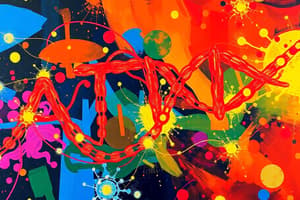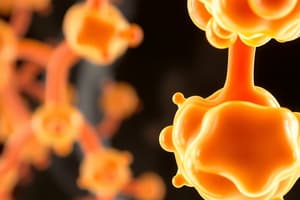Podcast
Questions and Answers
What is the result of the reaction that involves FAD in the citric acid cycle?
What is the result of the reaction that involves FAD in the citric acid cycle?
- Conversion of fumarate to malate
- Formation of FADH
- Formation of malate
- Conversion of succinate to fumarate (correct)
What product is formed when pyruvate is reduced under anaerobic conditions?
What product is formed when pyruvate is reduced under anaerobic conditions?
- Ethanol
- Glucose
- Acetyl-CoA
- Lactate (correct)
What primarily causes muscle soreness after intense exercise?
What primarily causes muscle soreness after intense exercise?
- Depletion of oxygen
- Accumulation of glucose
- Build-up of fatty acids
- Accumulation of lactate (correct)
What is one of the key components that make up coenzyme A?
What is one of the key components that make up coenzyme A?
During the citric acid cycle, what does acetyl-CoA combine with?
During the citric acid cycle, what does acetyl-CoA combine with?
Which statement accurately describes glycolysis?
Which statement accurately describes glycolysis?
During the first three reactions of glycolysis, what is primarily consumed?
During the first three reactions of glycolysis, what is primarily consumed?
How many CO₂ molecules are released during one complete turn of the citric acid cycle?
How many CO₂ molecules are released during one complete turn of the citric acid cycle?
What is converted to fructose-1,6-bisphosphate in glycolysis?
What is converted to fructose-1,6-bisphosphate in glycolysis?
What happens to NAD⁺ and FAD during the citric acid cycle?
What happens to NAD⁺ and FAD during the citric acid cycle?
In the citric acid cycle, what is one of the products formed from the conversion of GDP?
In the citric acid cycle, what is one of the products formed from the conversion of GDP?
What is the end product of glycolysis from one molecule of glucose?
What is the end product of glycolysis from one molecule of glucose?
Why is the citric acid cycle particularly important for certain tissues?
Why is the citric acid cycle particularly important for certain tissues?
How much ATP is generated during the last five reactions of glycolysis?
How much ATP is generated during the last five reactions of glycolysis?
Which electron carriers are generated during the citric acid cycle?
Which electron carriers are generated during the citric acid cycle?
What does the thiol group of coenzyme A bond to?
What does the thiol group of coenzyme A bond to?
What is the significance of the term bisphosphate in fructose-1,6-bisphosphate?
What is the significance of the term bisphosphate in fructose-1,6-bisphosphate?
Which reaction represents the cleavage of fructose-1,6-bisphosphate?
Which reaction represents the cleavage of fructose-1,6-bisphosphate?
What happens to dihydroxyacetone phosphate in the glycolysis pathway?
What happens to dihydroxyacetone phosphate in the glycolysis pathway?
What is the primary function of the Electron Transport Chain (ETC) in cellular respiration?
What is the primary function of the Electron Transport Chain (ETC) in cellular respiration?
During which reaction does the aldehyde group of glyceraldehyde-3-phosphate get oxidized?
During which reaction does the aldehyde group of glyceraldehyde-3-phosphate get oxidized?
What is the primary purpose of glycolysis in high energy demanding tissues?
What is the primary purpose of glycolysis in high energy demanding tissues?
What happens to protons (H⁺ ions) during the process of oxidative phosphorylation?
What happens to protons (H⁺ ions) during the process of oxidative phosphorylation?
How many ATP molecules are yielded from one glucose molecule during glycolysis?
How many ATP molecules are yielded from one glucose molecule during glycolysis?
How many ATP molecules are produced after the phosphorylation from 1,3-bisphosphoglycerate to ADP?
How many ATP molecules are produced after the phosphorylation from 1,3-bisphosphoglycerate to ADP?
Which molecule is primarily produced during the citric acid cycle?
Which molecule is primarily produced during the citric acid cycle?
Which enzyme does not participate as a control point in the glycolysis pathway?
Which enzyme does not participate as a control point in the glycolysis pathway?
What is the consequence of oxygen being unavailable for the Electron Transport Chain?
What is the consequence of oxygen being unavailable for the Electron Transport Chain?
What transformation occurs during the isomerization of 3-phosphoglycerate?
What transformation occurs during the isomerization of 3-phosphoglycerate?
Which statement correctly describes a reaction occurring in glycolysis?
Which statement correctly describes a reaction occurring in glycolysis?
How many NADH molecules are produced from the conversion of two moles of pyruvate to acetyl CoA?
How many NADH molecules are produced from the conversion of two moles of pyruvate to acetyl CoA?
What is formed as a result of the dehydration reaction in glycolysis?
What is formed as a result of the dehydration reaction in glycolysis?
What happens to pyruvate during anaerobic respiration?
What happens to pyruvate during anaerobic respiration?
What is the final product of the second direct phosphate transfer in glycolysis?
What is the final product of the second direct phosphate transfer in glycolysis?
Which component of cellular respiration uses ATP synthase to generate ATP?
Which component of cellular respiration uses ATP synthase to generate ATP?
Which of the following reactions is classified as 'cleavage' in glycolysis?
Which of the following reactions is classified as 'cleavage' in glycolysis?
In which part of the mitochondria does the electron transport chain occur?
In which part of the mitochondria does the electron transport chain occur?
When oxygen is available, what does pyruvate convert to in the mitochondria?
When oxygen is available, what does pyruvate convert to in the mitochondria?
What drives the synthesis of ATP during oxidative phosphorylation?
What drives the synthesis of ATP during oxidative phosphorylation?
What is the net ATP change during the conversion of glucose to pyruvate in glycolysis?
What is the net ATP change during the conversion of glucose to pyruvate in glycolysis?
How many ATP molecules are produced from the 2 NADH formed in glycolysis?
How many ATP molecules are produced from the 2 NADH formed in glycolysis?
What is the total yield of ATP from 6 NADH in the citric acid cycle?
What is the total yield of ATP from 6 NADH in the citric acid cycle?
What is the net yield of ATP from the complete oxidation of 1 mol of glucose?
What is the net yield of ATP from the complete oxidation of 1 mol of glucose?
What is the ATP yield from 2 FADH2 formed in the citric acid cycle?
What is the ATP yield from 2 FADH2 formed in the citric acid cycle?
How many ATP are consumed during the conversion of glucose to glucose-6-phosphate?
How many ATP are consumed during the conversion of glucose to glucose-6-phosphate?
Which process produces 2 GTP molecules that can be converted to ATP?
Which process produces 2 GTP molecules that can be converted to ATP?
How many ATP equivalents are produced from the oxidation of pyruvate?
How many ATP equivalents are produced from the oxidation of pyruvate?
What is the total ATP produced from 2 mol of glyceraldehyde-3-phosphate in glycolysis?
What is the total ATP produced from 2 mol of glyceraldehyde-3-phosphate in glycolysis?
During glycolysis, how many ATP are produced from 2 molecules of phosphoenolpyruvate?
During glycolysis, how many ATP are produced from 2 molecules of phosphoenolpyruvate?
Which step in glycolysis consumes 1 ATP to convert fructose-1,6-bisphosphate into glyceraldehyde-3-phosphate?
Which step in glycolysis consumes 1 ATP to convert fructose-1,6-bisphosphate into glyceraldehyde-3-phosphate?
Flashcards
Citric acid cycle reaction using FAD
Citric acid cycle reaction using FAD
Conversion of succinate's single carbon bond to a double bond in fumarate, producing FADH2.
Coenzyme A (CoA)
Coenzyme A (CoA)
A molecule that's not involved in redox reactions; composed of pantothenic acid, ADP, and aminoethanethiol.
CoA's important feature
CoA's important feature
The thiol group allows CoA to bond with two-carbon acetyl groups, creating acetyl CoA.
Glycolysis
Glycolysis
Signup and view all the flashcards
Glycolysis location
Glycolysis location
Signup and view all the flashcards
Energy investment in glycolysis
Energy investment in glycolysis
Signup and view all the flashcards
Fructose-1,6-bisphosphate
Fructose-1,6-bisphosphate
Signup and view all the flashcards
Reaction 1 of Glycolysis
Reaction 1 of Glycolysis
Signup and view all the flashcards
Fructose-1,6-bisphosphate cleavage
Fructose-1,6-bisphosphate cleavage
Signup and view all the flashcards
Dihydroxyacetone phosphate isomerization
Dihydroxyacetone phosphate isomerization
Signup and view all the flashcards
Glyceraldehyde-3-phosphate oxidation
Glyceraldehyde-3-phosphate oxidation
Signup and view all the flashcards
1,3-bisphosphoglycerate formation
1,3-bisphosphoglycerate formation
Signup and view all the flashcards
ATP production (Reaction 7)
ATP production (Reaction 7)
Signup and view all the flashcards
3-phosphoglycerate isomerization
3-phosphoglycerate isomerization
Signup and view all the flashcards
Dehydration of 2-phosphoglycerate
Dehydration of 2-phosphoglycerate
Signup and view all the flashcards
ATP production (Reaction 10)
ATP production (Reaction 10)
Signup and view all the flashcards
Anaerobic Fermentation
Anaerobic Fermentation
Signup and view all the flashcards
Lactate Buildup
Lactate Buildup
Signup and view all the flashcards
Oxygen Debt
Oxygen Debt
Signup and view all the flashcards
Citric Acid Cycle: Location
Citric Acid Cycle: Location
Signup and view all the flashcards
Citric Acid Cycle: Input
Citric Acid Cycle: Input
Signup and view all the flashcards
Citric Acid Cycle: Output
Citric Acid Cycle: Output
Signup and view all the flashcards
Electron Carriers in Citric Acid Cycle
Electron Carriers in Citric Acid Cycle
Signup and view all the flashcards
Citric Acid Cycle: Significance
Citric Acid Cycle: Significance
Signup and view all the flashcards
Glycolysis ATP yield
Glycolysis ATP yield
Signup and view all the flashcards
Glycolysis Role
Glycolysis Role
Signup and view all the flashcards
Pyruvate fate (aerobic)
Pyruvate fate (aerobic)
Signup and view all the flashcards
Pyruvate fate (anaerobic)
Pyruvate fate (anaerobic)
Signup and view all the flashcards
Glycolysis control points
Glycolysis control points
Signup and view all the flashcards
Glucose-6-phosphate formation (Glycolysis)
Glucose-6-phosphate formation (Glycolysis)
Signup and view all the flashcards
Fructose-1,6-bisphosphate cleavage reaction
Fructose-1,6-bisphosphate cleavage reaction
Signup and view all the flashcards
Phosphorylation in Glycolysis
Phosphorylation in Glycolysis
Signup and view all the flashcards
Electron Transport Chain
Electron Transport Chain
Signup and view all the flashcards
Oxidative Phosphorylation
Oxidative Phosphorylation
Signup and view all the flashcards
Proton Gradient
Proton Gradient
Signup and view all the flashcards
ATP Synthase
ATP Synthase
Signup and view all the flashcards
Why is Oxygen Essential for ETC?
Why is Oxygen Essential for ETC?
Signup and view all the flashcards
Importance of ETC
Importance of ETC
Signup and view all the flashcards
ETC and Energy Demands
ETC and Energy Demands
Signup and view all the flashcards
Anaerobic Respiration
Anaerobic Respiration
Signup and view all the flashcards
Pyruvate Oxidation ATP Yield
Pyruvate Oxidation ATP Yield
Signup and view all the flashcards
Citric Acid Cycle ATP Yield
Citric Acid Cycle ATP Yield
Signup and view all the flashcards
Electron Transport Chain ATP Yield
Electron Transport Chain ATP Yield
Signup and view all the flashcards
Total ATP Yield
Total ATP Yield
Signup and view all the flashcards
Cytoplasmic NADH
Cytoplasmic NADH
Signup and view all the flashcards
Mitochondrial NADH
Mitochondrial NADH
Signup and view all the flashcards
FADH2 Role
FADH2 Role
Signup and view all the flashcards
ATP Usage
ATP Usage
Signup and view all the flashcards
Study Notes
Metabolic Pathways and Energy Production
- Metabolic pathways are a series of chemical reactions that provide energy and the necessary substances for continued cell growth
- Two types of metabolic reactions are catabolic and anabolic
- Catabolic reactions break down complex molecules into simpler ones, releasing energy
- Anabolic reactions build large molecules from simpler ones, requiring energy
- ATP is a high-energy compound that stores the energy released from the oxidation of food in cells
Learning Objectives
- Understand the process of catabolism and the structure of ATP
- Identify the components and functions of coenzymes (NAD+, NADP+, FAD, and coenzyme A)
- Explain the processes of glycolysis, the citric acid cycle, and the electron transport chain
- Create an audio-visual presentation showcasing metabolic pathways
Metabolism and ATP Energy
- Metabolism encompasses all chemical reactions essential for cellular processes and growth
- During catabolism, nutrients are broken down to release energy in the form of ATP
- During anabolism, energy drives the synthesis of complex molecules, like proteins, from simpler building blocks
- ATP is the primary energy currency of cells, storing and transferring energy
Digestion of Foods
- Food is broken down into smaller units for absorption and utilization
- Fats are emulsified by bile salts, breaking them into smaller droplets for enzyme action
- Carbohydrates are broken down by enzymes into monosaccharides for absorption
- Proteins are broken down into amino acids for digestion
Digestion of Carbohydrates
- Salivary enzymes initially break down carbohydrates, and digestion continues in the stomach
- Smaller carbohydrates like maltose, glucose are produced in the digestive process by enzymatic hydrolysis
- Absorbed into bloodstream and converted into glucose, enabling utilization throughout the body
Digestion of Fats
- Bile salts emulsify fats into smaller droplets
- Pancreatic enzymes like lipase hydrolyze fats, forming fatty acids and glycerol
- These components are absorbed into the lymphatic system and later into the bloodstream enabling cell use
Digestion of Proteins
- Stomach acid (HCl) denatures proteins and activates enzymes like pepsin in hydrolysis to polypeptides
- Small intestine enzymes (trypsin, chymotrypsin) further hydrolyze polypeptides into amino acids
- Absorbed into the bloodstream for cellular use
Coenzymes in Metabolic Pathways
- Oxidation involves hydrogen loss, electron loss, or oxygen gain
- Reduction involves hydrogen gain, electron gain, or oxygen loss
- Coenzymes facilitate these reactions by aiding in electron transferring. Examples include NAD+ and FAD.
NAD+
- NAD+ (nicotinamide adenine dinucleotide) facilitates oxidation-reduction reactions in the body
- The B3 vitamin niacin provides the nicotinamide group, forming NAD+ molecule
- NAD+ is reduced to NADH during reactions, utilizing stored energy
NAD+ (Metabolic reactions)
- NAD+ is required for metabolic reactions involving carbon-oxygen (C=O) bonds
- The body uses NAD+ in oxidation of alcohols to aldehydes and ketones
- NADH is produced when ethanol is converted to ethanal
FAD
- FAD (flavin adenine dinucleotide) is a coenzyme involved in electron transfer
- It's derived from the B2 vitamin riboflavin and flavin ring structure
- Involved in dehydrogenation reactions where single bonds become double bonds
Coenzyme A (CoA)
- CoA, not involved in redox reactions, is made of pantothenic acid (vitamin B5), ADP, and aminoethanethiol
- The key component is the thiol group, enabling CoA to bind with acetyl groups
- CoA formation creates energy rich thioester acetyl CoA enabling transport
Types of Metabolic Reactions
- The main categories are anabolism and catabolism
- Metabolic reactions synthesize complex molecules (anabolism) or break them down (catabolism)
- Anabolic reactions utilize energy to build; catabolic reactions release energy
Glycolysis: Oxidation of Glucose
- Glycolysis is an anaerobic process, using glucose to generate energy
- It involves multiple reactions, including substrate-level phosphorylation
- Glucose (6 carbons) is converted to 2 molecules of pyruvate, each with 3 carbons
- Byproducts like NADH are created, while 2 ATP are produced per glucose molecule
Importance of Glycolysis
- Important for highly energy demanding tissues like muscles & brains
- Glycolysis provides rapid energy when oxygen is limiting
- Pyruvate products enter the mitochondria if oxygen is available; it may be converted into lactate if oxygen is limited & converted to lactate
Regulation of Glycolysis
- Glycolysis is regulated at key points; there are 3 primary control points in glycolysis (hexokinase, phosphofructokinase, pyruvate kinase)
- These points act as control centers, ensuring that glycolysis adapts based on energy needs, ensuring energy is provided as needed.
ATP Yield from the Complete Oxidation of 1 mol of Glucose
- Different reactions produce variable amounts of ATP during glucose oxidation
- Various steps of glucose oxidation, from the initial steps of Glycolysis to the citric acid cycle and electron transport chain generate variable levels of ATPs (depending on efficiency step)
Pathways for Pyruvate
- Pyruvate is converted to acetyl CoA during aerobic conditions
- Pyruvate is converted into lactate under anaerobic conditions
- Lactate buildup can cause muscle fatigue and pain following workout activity
Krebs Cycle (Citric Acid Cycle)
- Acetyl CoA combines with oxaloacetate to form citrate starting the cycle
- The cycle runs in multiple stages through various steps
- The cycle releases two CO2 molecules per cycle
- Energy carriers (NADH, FADH2) are produced & carry energy for later ATP production, via electron transport chain
Importance of Krebs Cycle
- Critical for transferring electrons via coenzyme NADH and FADH2, which are essential for ATP production
- The cycle plays a vital role in oxidizing carbohydrates, fats, proteins for energy requirements of the body
Electron Transport Chain
- NADH and FADH2 molecules formed during glycolysis and Krebs cycle are pivotal in electron transfer processes along the chain.
- Electrons are transferred through complexes embedded in the inner mitochondrial membrane
- During electron transfer, protons and energy is captured and delivered to build ATP. This mechanism is very efficient
Oxidative Phosphorylation
- As electrons pass between complexes in electron transport chain, protons are pumped from the mitochondrial matrix to the intermembrane space generating proton gradient
- Protons flow back from intermembrane space to the mitochondrial matrix via a protein complex
- Movement produces enough energy to synthesis ATP, from ADP and phosphate molecules. This conversion is efficient.
Importance of Electron Transport Chain
- A major ATP producer, powering various cellular functions
- Requires oxygen, & stops ATP production when oxygen is not available
- Essential for organs with high energy demands like heart and brain; muscle contractions and nerve impulses depend on it.
ATP Yield from the Complete Oxidation of 1 mol of Glucose
- The complete oxidation of a single glucose molecule generates a significant amount of ATP, which comes from various steps
- Details of how much ATP is produced at each step
Overview of Glucose Metabolism (Overview)
- Glucose is broken down in stages, yielding ATP byproducts
- Key stages of glycolysis, Krebs cycle, and electron transport chain are clearly defined steps. Each producing varying amounts of ATP.
- The entire pathway is regulated which ensures sufficient production and utilization of energy
Studying That Suits You
Use AI to generate personalized quizzes and flashcards to suit your learning preferences.




